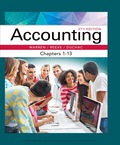
Deferrals:
Deferrals refer to the revenues that are collected in advance before the services are provided or sales are made to the customer, and the expenses are paid in advance before the expenses are incurred.
Deferrals are classified into two types. They are prepaid expenses, and unearned revenues.
Prepaid expenses: The expenses are paid in cash, before they are incurred.
Unearned revenue: The cash is received, before the services are performed.
Accruals:
Accruals refer to the revenues that are generated from goods delivered or, service performed to the customer, but cash is not yet received from the customer, and the expenses are incurred, but cash is not yet paid.
Accruals are classified into two types. They are accrued revenues, and accrued expenses.
Accrued revenues: Revenues are generated but not yet received in cash.
Accrued expenses: Expenses are incurred but not yet paid in cash.
To indicate: The types of adjustment for the given transactions.
Want to see the full answer?
Check out a sample textbook solution
Chapter 3 Solutions
EBK ACCOUNTING, CHAPTERS 1-13
- Sequoia Resorts pays $780,000 plus $17,500 in closing costs to buy out a competitor. The real estate consists of land appraised at $95,000, a building appraised at $342,000, and recreational equipment appraised at $398,000. Compute the cost that should be allocated to the building.arrow_forwardI need help with this solution and general accounting questionarrow_forwardCozy Retreats currently sells 420 Standard hot tubs, 580 Luxury hot tubs, and 190 Premium model hot tubs each year. The firm is considering adding a Comfort model hot tub and expects that, if it does, it can sell 340 of them. However, if the new hot tub is added, standard sales are expected to decline to 290 units while Luxury sales are expected to decline to 310. The sales of the Premium model will not be affected. Standard hot tubs sell for an average of $8,900 each. Luxury hot tubs are priced at $14,500 and the Premium model sells for $22,000 each. The new Comfort model will sell for $12,300. What is the value of erosion?arrow_forward
- Salma Production uses direct labor cost as the allocation base for applying MOH to WIP. The budgeted direct labor cost for the year was $850,000. The budgeted manufacturing overhead was $722,500. The actual direct labor cost for the year was $910,000. The actual manufacturing overhead was $745,000. A. What was Salma's predetermined manufacturing overhead rate per direct labor dollars? B. How much MOH was applied to WIP during the year?arrow_forwardHello tutor solve this question and accountingarrow_forwardThe total factory overhead for Leicester Manufacturing is budgeted for the year at $756,000. Leicester manufactures two product lines: standard lamps and premium lamps. These products each require 4 direct labor hours to manufacture. Each product is budgeted for 8,000 units of production for the year. Determine the factory overhead allocated per unit for premium lamps using the single plantwide factory overhead rate.arrow_forward
- I need help with this solution and accounting questionarrow_forwardhttps://investor.exxonmobil.com/sec-filings/annual-reports/content/0000034088-25-000010/0000034088-25-000010.pdf Use link to help me answer my question please in picturearrow_forwardHello tutor solve this question and accountingarrow_forward
- Can you solve this general accounting question with accurate accounting calculations?arrow_forwardPlease provide the solution to this general accounting question with accurate financial calculations.arrow_forwardI need help with this general accounting problem using proper accounting guidelines.arrow_forward
- Principles of Accounting Volume 1AccountingISBN:9781947172685Author:OpenStaxPublisher:OpenStax College
 Cornerstones of Financial AccountingAccountingISBN:9781337690881Author:Jay Rich, Jeff JonesPublisher:Cengage LearningCentury 21 Accounting Multicolumn JournalAccountingISBN:9781337679503Author:GilbertsonPublisher:Cengage
Cornerstones of Financial AccountingAccountingISBN:9781337690881Author:Jay Rich, Jeff JonesPublisher:Cengage LearningCentury 21 Accounting Multicolumn JournalAccountingISBN:9781337679503Author:GilbertsonPublisher:Cengage  College Accounting, Chapters 1-27AccountingISBN:9781337794756Author:HEINTZ, James A.Publisher:Cengage Learning,
College Accounting, Chapters 1-27AccountingISBN:9781337794756Author:HEINTZ, James A.Publisher:Cengage Learning,




